火星 月惑星研究会 関西支部

Mars Image 2005/09/19(UT)
柚木健吉,畑中明利,安達 誠,
Clay Sherrod,Ralf Vandebergh,Sean Walker,David M Moore,Diego Barucco,Paulo Casquinha,John Kirchhoff,Christophe Pellier
K.Yunoki,A.Hatanaka,M.Adachi,Clay,R.Vandebergh,Walker,D.Moore,D.Barucco,P.Casquinha,J.Kirchhoff,Christophe.P
解説(安達)
シレーン(Mare Sirenum;160W,-30)は朝霧の下でも非常に濃く見えている。
柚木氏の画像からは氷晶雲が出ていることが分かる。とくにタルス
(Tharsis;95W,+5)付近に、濃い部分のあることが分かる。 P. Clay Sherrod
とDavid M Mooreの画像からは、アキダリウム(Mare Acidarium;30W,+50)には
っきりした、低気圧性の雲をとらえている。この雲は、同じところで見えるこ
とが多いようだ。Cristophe Pellierの画像からは低位緯度の氷晶雲が良く捉
えられている。(reported by 11 observers)
Mare Sirenum (160W,-30) looks very thick under the morning mist. It
is understood that the cloud appears from the image of Yunoki.
Especially, it is understood that in the vicinity of Tharsis
(Tharsis;95W,+5), there is a thick part. A low-pressure water ice
cloud clear from the image of P. Clay Sherrod and David M Moore to
Mare Acidarium is caught. It often seems to see this cloud at the same.
The water ice cloud of minor latitude is caught from the image of
Cristophe Pellier well. (reported by 11 observers)
FROM Makoto ADACHI
-------------------------------------------------------------------------------------
|
Kenkichi.Yunoki (200mm Newtonian, ToUcam Pro)
|
天気予報では曇りだったが、薄いベールに覆われながらも火星が出ている。撮像を始めるが月に暈がかかりそうな透明度なので、拡大率を普段よりも下げて撮像。シーイングは高度が上がるにつれて良くなっていった。透明度が良ければとも思うが、期待していなかった天候故、贅沢は言えないかも知れない。アルシアモンスの雲は18日は西に長く流れている様子だったが、19日はその流れがなくなった様にも見える。
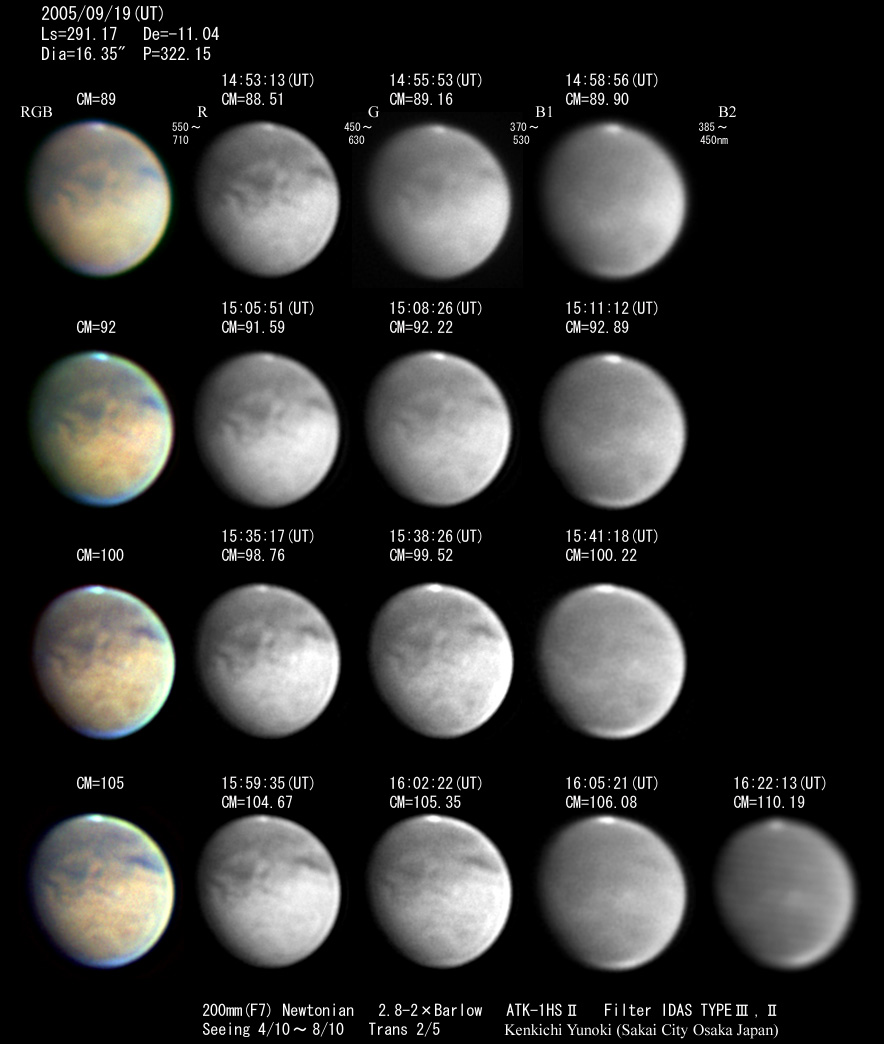
[Kenkichi Yunoki (Sakai City Japan)]
≪大阪府 堺市 柚木健吉≫
|
Akitoshi Hatanaka (400mm Cassegrain, ToUcam Pro)
|
40cm Cassegrain(F15) 1 degree Prisum IR block Filter
Philips ToUcam Pro Rezistax 3 seeing 5/10 trans 6/10
2時過ぎからうろこ雲が出て、思うように撮影できなかった。
オリンポス山は、特定できるが、そのほかに特定できないような
模様も写っており、ノイズの影響か?と考えています。
ATKは、ノイズが少ないのですが、カラー画像が撮れないので
ついついToUcamを使ってしまいます。
ソリスのすぐ西に明るい部分があるようです。
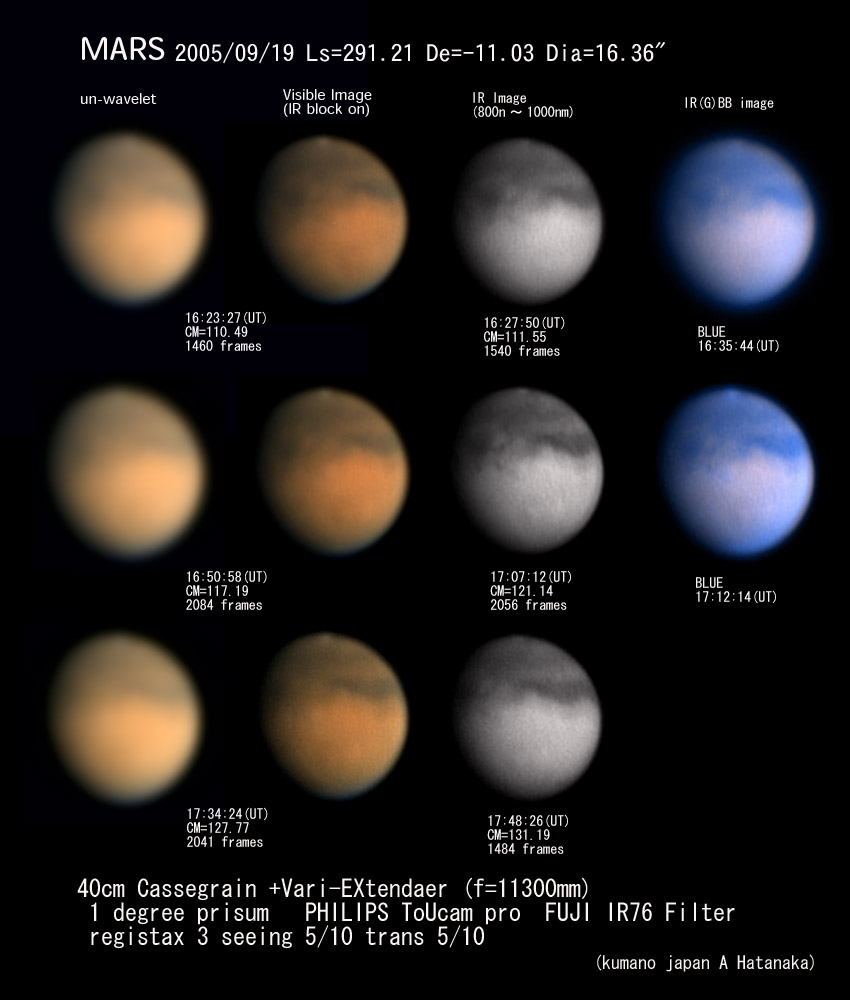 ≪三重県熊野市 畑中明利≫
≪三重県熊野市 畑中明利≫
|
Makoto Adachi (Drawing: 310mm Newtonian)
|
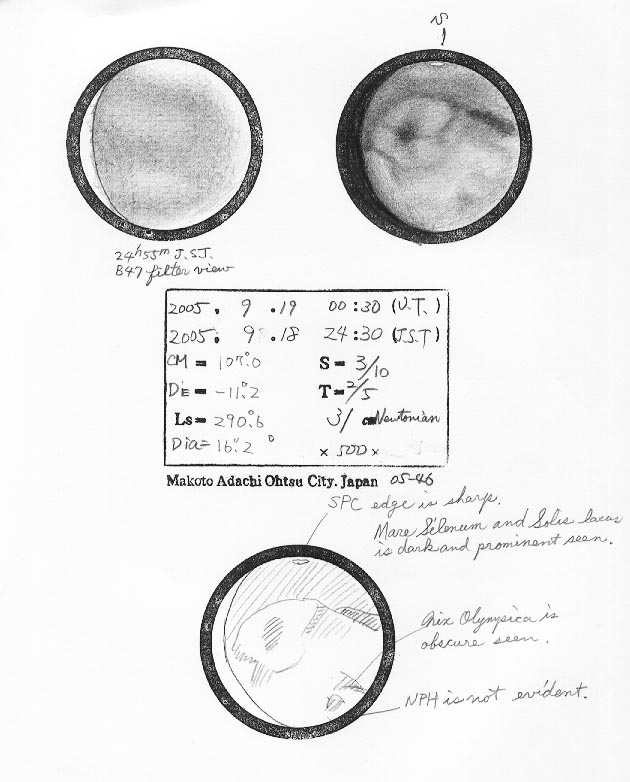
----------------------------------------------------------------------------------------------
<Makoto Adochi Ohtu Shiga Japan>
≪滋賀県 大津市 安達 誠≫
|
Dr. P. Clay Sherrod (410mm SC : ToUcam PRO)
|
Mars in variable seeing, showing the persistence of the very bright blue cloud over the
north polar region. I believe that the intensity of the central part of this feature is
actually greater than on previous dates.
The large cloud (?) over the north polar region (bottom in this image) continues in both
area coverage and intensity, with a very strong point of central condensation. What
appear to irradiating lines emanating from the central point of brightening are very
curious and not spurious, as these were recorded on Sept. 17. The lack of any indication
of circulatory change during the past week should be something to consider as to the
nature of this bright feature.
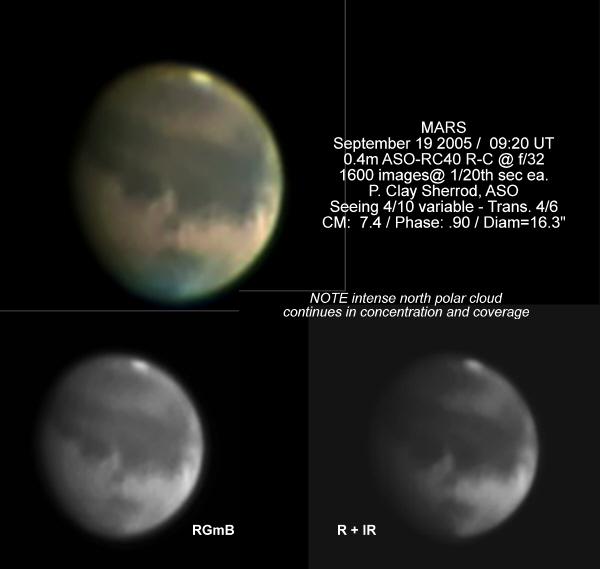 [Dr. P. Clay Sherrod Arkansas State U.S.A]
[Dr. P. Clay Sherrod Arkansas State U.S.A]
|
Ralf Vandebergh(250mm Newton:ATK-1HS)
|
|
Sept 19, Mars observing session in very good seeing with long moments of exellent seeing,especially in the period
around 01-02:00 UTC.
Here is a first result.This is an animation showing the differences in the Syrtis Major/Hellas region showing in the
near-infrared,intergrated light,and high contrast blue light.Especially the blue light image is interesting with its
presentation of atmospheric features compared to the IR image.
10 inch Newton & ATK-1HS images taken at 0.08´´/p res f/60.
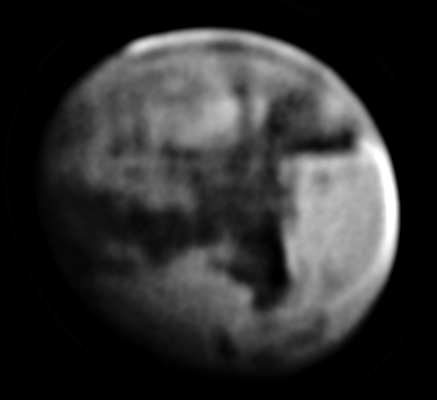 An image taken under good seeing conditions/exellent transparance at 03:21 UTC
Nodus Alcyonius is obvious present near the terminator.
10 inch Newton & ATK-1HS @0.08´´/p res. f/60.
An image taken under good seeing conditions/exellent transparance at 03:21 UTC
Nodus Alcyonius is obvious present near the terminator.
10 inch Newton & ATK-1HS @0.08´´/p res. f/60.
 [バンディバ:オランダ]
[Ralf Vandebergh:Neighbourhood of Maastricht Netherlands]
[バンディバ:オランダ]
[Ralf Vandebergh:Neighbourhood of Maastricht Netherlands]
|
Sean Walker(127mm Maksutov-Newtonian:ToUCam pro)
|
6:35 UT, seeing=good/excellent, transparency=good
18 cm Mak-Newt @f/80, ToUcam pro, IRGB
 [ Sean Walker , Massachusetts, U.S.A]
[ Sean Walker , Massachusetts, U.S.A]
|
David M. Moore(25cm Newtonian, Philips ToUcam)
|
Seeing began good, but deteriorated rapidly. I omitted the last image set. The NPH is showing good development.
I see some of our good Yahoo folks have stirred the pot again! I enclose an image from last rotation on August 18,2005. It clearly shows hints of the same phenomenon in the Mare Acidalium area and is not new to many of us. Grafton and I have imaged this area's phenomena for several rotations and the past several apparitions as well. Mare Acidalium's topography or something appears to draw the Hood farther South in this region. The Hood always seems brighter here too. The area has only shown hints of this however and has not been near as visible to us till now. The striations in the Hood are most curious.
I think that as Mars draws closer, each rotation is amazing all of us and showing us more than we have ever seen before. We are getting the first good glance of the North as the Martian declination declines and therefore are getting a better insight of the Hood forming. For most of us we have never had the technology to image like this before. It is not necessarily anything new to Mars, but new to us!
As for dust, I still look for obscuration. We must be careful not to jump to conclusions as image processing can cause artifacts and highlights simple bright areas of Mars. We have already witnessed this several times this year. My two cents worth.
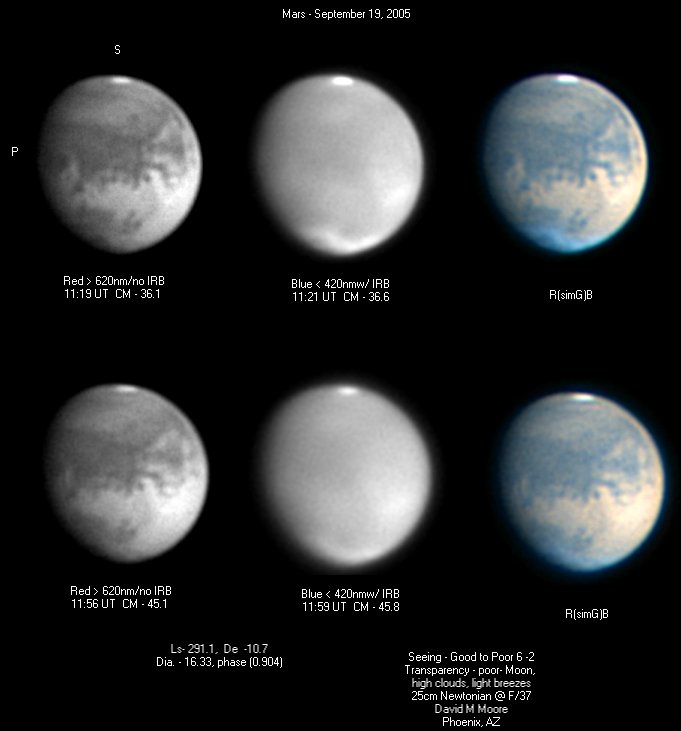
[ Arizona U.S.A]
|
Diego Barucco(250mm newtonian:ES640 Astromeccanica)
|
2005/09/19 00:26 (UT) 250mm newtonian ES640 astromeccanica
seeing 4 /10; trasp 6 /10

[Diego Barucco:Siracusa Italy]
|
Paulo Casquinha (250 mm Newtonian Reflector:Toucam Pro)
|
Mars taken with fair seeing and good transparency
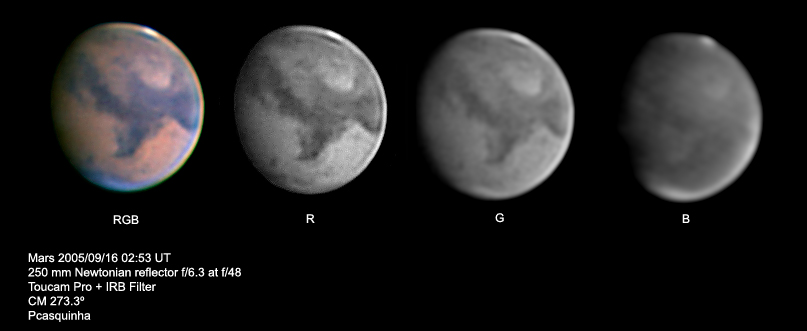 (site: 38.567 N /8.933 W Alt 124 m)
[Paulo Casquinha Palmela, Portugal]
(site: 38.567 N /8.933 W Alt 124 m)
[Paulo Casquinha Palmela, Portugal]
|
John Kirchhoff(235mm SCT" ToUcam)
|
Good seeing conditions but high clouds due to approaching weather system really hampered transparency. I had to set the camera gain to 95% and the image was still rather dark. The NPH is still very evident and is very intersting to watch

[John Kirchhoff Hudson, Michigan, U.S.A.]
|
Christophe Pellier (C14 ; Lumenera ATK-1HS)
|
The whole area north-west of Syrtir Major and Mare Tyhrrenum is largely cloudy.
Do you guys find any interest to the false color image ? Think it might enhance the areas where the atmosphere is clear, but a comparison bewteen violet and R or IR images split may be more efficient...
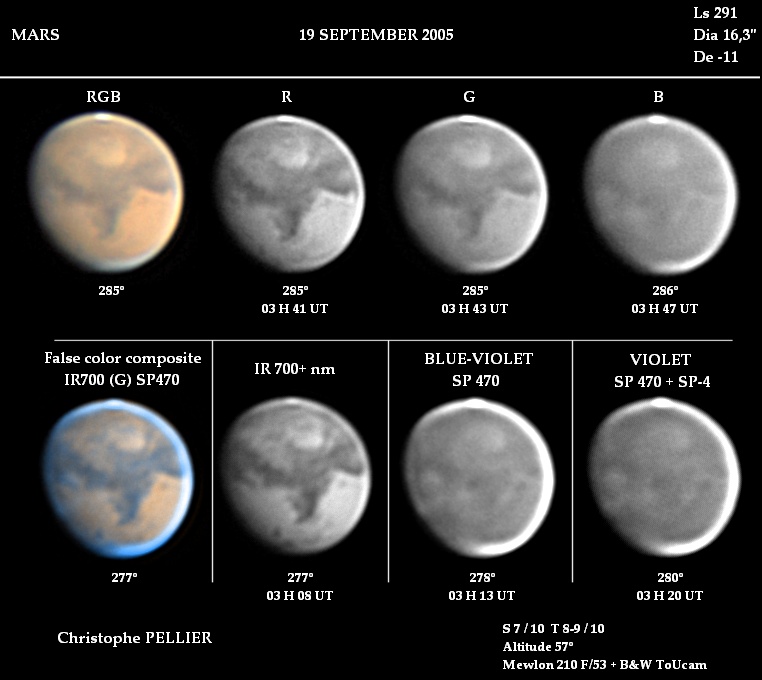
[Christophe Pellier Bruz City , France]


 ≪三重県熊野市 畑中明利≫
≪三重県熊野市 畑中明利≫
 [Dr. P. Clay Sherrod Arkansas State U.S.A]
[Dr. P. Clay Sherrod Arkansas State U.S.A] An image taken under good seeing conditions/exellent transparance at 03:21 UTC
Nodus Alcyonius is obvious present near the terminator.
10 inch Newton & ATK-1HS @0.08´´/p res. f/60.
An image taken under good seeing conditions/exellent transparance at 03:21 UTC
Nodus Alcyonius is obvious present near the terminator.
10 inch Newton & ATK-1HS @0.08´´/p res. f/60.
 [バンディバ:オランダ]
[Ralf Vandebergh:Neighbourhood of Maastricht Netherlands]
[バンディバ:オランダ]
[Ralf Vandebergh:Neighbourhood of Maastricht Netherlands] [ Sean Walker , Massachusetts, U.S.A]
[ Sean Walker , Massachusetts, U.S.A]

 (site: 38.567 N /8.933 W Alt 124 m)
[Paulo Casquinha Palmela, Portugal]
(site: 38.567 N /8.933 W Alt 124 m)
[Paulo Casquinha Palmela, Portugal] 

 ALPO-Japan Latest
ALPO-Japan Latest